#bibliometric and content analysis
Text
#bibliometric analysis#bibliometric analysis methodology#bibliometric analysis research paper#bibliometric and content analysis#bibliometric and content analysis pdf#bibliometric research#data analysis services#statistical data analysis
0 notes
Text
Expert Guidance for Writing a Standout Research Proposal in India: Bibliometrics, Content Analysis, and More
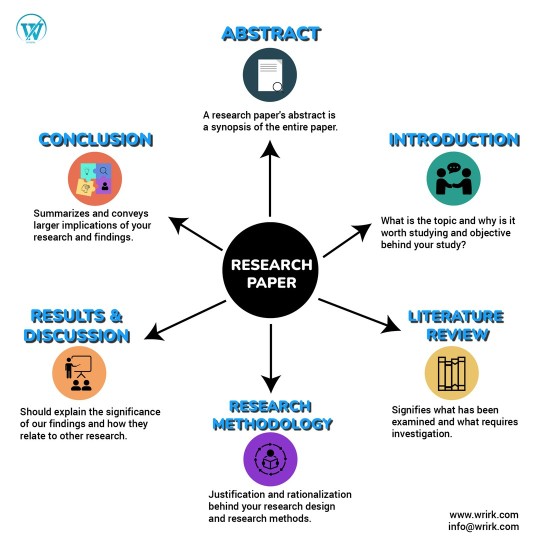
Are you a PhD student in India looking to write a research proposal? Look no further! Our team at wrirk.com offers expert guidance in bibliometric and content analysis to ensure your proposal stands out. Our implementation research toolkit is a valuable resource for any researcher. In addition, we offer online thesis writing services to make the process as smooth as possible. Need help with the synopsis format for your project or the thesis writing format in pdf? We've got you covered. Contact us today for a consultation and take the first step towards a successful research proposal. #researchproposal #phd #india #bibliometrics #contentanalysis #implementationresearch #thesiswriting #synopsisformat #thesisformat
#sample research proposal for phd in india#bibliometric and content analysis#implementation research toolkit#PhD Research Proposal Writing Services India#Online thesis writing services in India#research proposal sample for phd#synopsis format for project#phd research proposal sample pdf#research paper example pdf#thesis writing format pdf#research synopsis example pdf
1 note
·
View note
Link
The 2023 Annual Highlights of Results from the International Space Station is now available. This new edition contains bibliometric analyses, a list of all the publications documented in fiscal year 2023, and synopses of the most recent and recognized scientific findings from investigations conducted on the space station. These investigations are sponsored by NASA and all international partners – CSA (Canadian Space Agency), ESA (European Space Agency), JAXA (Japan Aerospace Exploration Agency), and the State Space Corporation Roscosmos (Roscosmos) – for the advancement of science, technology, and education. These new peer-reviewed publications include insights that advance the commercialization of space and benefit humankind. Over 4,000 scientific publications have been collected from more than 5,000 investigators during the life of the space station. Between Oct. 1, 2022, and Sept. 30, 2023, more than 300 publications were reported, most of them undergoing rigorous scientific review before release and dissemination. An in-depth bibliometric analysis of station science shows that the citation impact of these publications has been above national and global standards since 2010. This impact demonstrates that space station science continues to produce groundbreaking results for investigators around the world to further explore. Some of the findings presented in this edition include: Improved measurement of cosmic particles (Italian Space Agency) New ultrasound technologies for detection of physiological changes (CSA) Enhanced understanding of coordinated function in brain activity (ESA) Development of better semiconductor materials (NASA) Impacts of spaceflight on connective tissue for improved tissue remodeling (ROSCOSMOS) Understanding the behavior of granular materials for better spacecraft design (JAXA) The content in the Annual Highlights of Results from the International Space Station has been reviewed and approved by the Program Science Forum, a team of scientists and administrators from the international partnership of space agencies dedicated to planning, improving, and communicating the research operated on the space station. See the list of Station Research Results publications here and read more about the space station’s annual highlights of results and accomplishments here. Keep Exploring Discover More Topics Space Station Research Results Space Station Research and Technology ISS National Laboratory Opportunities and Information for Researchers
0 notes
Text
Navigating the Academic Landscape: A Comprehensive Guide to Scopus Indexed Journals
Introduction:
In the dynamic realm of academic research, the choice of the right journal for publication is crucial. Researchers and scholars worldwide seek reputable platforms to disseminate their findings, and Scopus indexed journals have emerged as a gold standard in this regard. This article aims to provide a comprehensive guide to understanding Scopus indexed journals, their significance, and how researchers can access a curated list for their scholarly pursuits.
Understanding Scopus:
Scopus is a widely recognized abstract and citation database that covers a vast array of academic disciplines. Developed by Elsevier, Scopus indexes scholarly literature and provides valuable bibliometric tools to track, analyze, and visualize research output. It includes journals, conference proceedings, and patents, making it a multifaceted resource for researchers.
The Significance of Scopus Indexing:
Being indexed in Scopus carries significant prestige within the academic community. Journals included in the Scopus database undergo a rigorous evaluation process, ensuring that they meet stringent quality standards. The indexing process involves an assessment of a journal's editorial policies, peer review procedures, publication frequency, and international diversity. Inclusion in Scopus enhances a journal's visibility, credibility, and accessibility to a global audience.
How to Access the Scopus Indexed Journals List:
Researchers can access the list of Scopus indexed journals through the official Scopus website. The platform provides a user-friendly interface, allowing users to search for journals based on various criteria such as subject area, country, and publisher. Additionally, Scopus regularly updates its indexed journal list, ensuring researchers have access to the most current information.
Benefits of Publishing in Scopus Indexed Journals:
Global Visibility: Scopus indexed journals are widely recognized and accessed by researchers, academics, and professionals worldwide, increasing the visibility of published research.
Quality Assurance: The rigorous evaluation process for inclusion in Scopus ensures that the journals meet high-quality standards in terms of editorial practices and scholarly content.
Bibliometric Analysis: Scopus provides powerful tools for bibliometric analysis, allowing researchers to track citation metrics, h-index, and other performance indicators, which can be crucial for career advancement.
Interdisciplinary Reach: With coverage across various disciplines, Scopus offers a platform for interdisciplinary research, fostering collaboration and knowledge exchange.
Conclusion:
In the competitive landscape of academic publishing, researchers must make informed decisions about where to publish their work. Scopus indexed journals stand out as reputable and globally recognized platforms that uphold rigorous quality standards. By understanding the significance of Scopus indexing and utilizing the comprehensive list of indexed journals, researchers can navigate the academic landscape with confidence, ensuring the broad dissemination of their valuable contributions to the scholarly community.
Hyderabad,Telangana
Research #papers #publish
0 notes
Text
TOC: International Journal of Corpus Linguistics Vol. 28, No. 3 (2023)
ICYMI: 2023. iii, 169 pp.
Table of Contents
Articles
Things we smell and things they smell like: Communicatively relevant odours and odorants
Thomas Poulton
pp. 291–317
Assessing word commonness: Adding dispersion to frequency
Mikkel Ekeland Paulsen
pp. 318–343
Research trends in corpus linguistics: A bibliometric analysis of two decades of Scopus-indexed corpus linguistics research in arts and humanities
Peter Crosthwaite, Sulistya Ningrum & Martin Schweinberger
pp. 344–377
Differences in syntac http://dlvr.it/StnYxq
0 notes
Text
Is Metaverse in education a blessing or a curse: a combined content and bibliometric analysis | Smart Learning Environments | Full Text
See on Scoop.it - Education 2.0 & 3.0
The Metaverse has been the centre of attraction for educationists for quite some time. This field got renewed interest with the announcement of social media giant Facebook as it rebranding and positioning it as Meta. While several studies conducted literature reviews to summarize the findings related to the Metaverse in general, no study to the best of our knowledge focused on systematically summarizing the finding related to the Metaverse in education. To cover this gap, this study conducts a systematic literature review of the Metaverse in education. It then applies both content and bibliometric analysis to reveal the research trends, focus, and limitations of this research topic. The obtained findings reveal the research gap in lifelogging applications in educational Metaverse. The findings also show that the design of Metaverse in education has evolved over generations, where generation Z is more targeted with artificial intelligence technologies compared to generation X or Y. In terms of learning scenarios, there have been very few studies focusing on mobile learning, hybrid learning, and micro learning. Additionally, no study focused on using the Metaverse in education for students with disabilities. The findings of this study provide a roadmap of future research directions to be taken into consideration and investigated to enhance the adoption of the Metaverse in education worldwide, as well as to enhance the learning and teaching experiences in the Metaverse.
0 notes
Text
Crimson Publishers Impact Factor
Crimson Publishers Impact Factor
The impact factor (IF) or journal impact factor (JIF) of an academic journal
is a scientometric index that reflects the yearly average number of citations that recent articles published in a given journal received. It is frequently used as a proxy for the relative importance of a journal within its field; journals with higher impact factors are often deemed to be more important than those with lower ones.The impact factor is used to compare different journals within a certain field. The Web of Science indexes more than 11,500 science and social science journals.Journal impact factors are often used to evaluate the merit of individual articles and individual researchers.
This particular use of impact factors was summarised by Hoeffel:Impact Factor is not a perfect tool to measure the quality of articles but there is nothing better and it has the advantage of already being in existence and is, therefore, a good technique for scientific evaluation. Experience has shown that in each specialty the best journals are those in which it is most difficult to have an article accepted, and these are the journals that have a high impact factor. Most of these journals existed long before the impact factor was devised. The use of impact factor as a measure of quality is widespread because it fits well with the opinion we have in each field of the best journals in our specialty....In conclusion, prestigious journals publish papers of high level. Therefore, their impact factor is high, and not the contrary.As impact factors is a journal-level metric, rather than an article or individual level metric, this use is controversial. Garfield agrees with Hoeffel, but warns about the "misuse in evaluating individuals" because there is "a wide variation [of citations] from article to article within a single journal
Validity as a measure of importance
It has been stated that impact factors and citation analysis in general are affected by field-dependent factors which may invalidate comparisons not only across disciplines but even within different fields of research of one discipline. The percentage of total citations occurring in the first two years after publication also varies highly among disciplines from 1–3% in the mathematical and physical sciences to 5–8% in the biological sciences. Thus impact factors cannot be used to compare journals across disciplines.Because citation counts have highly skewed distributions, the mean number of citations is potentially misleading if used to gauge the typical impact of articles in the journal rather than the overall impact of the journal itself. For example, about 90% of Nature's 2004 impact factor was based on only a quarter of its publications, and thus the actual number of citations for a single article in the journal is in most cases much lower than the mean number of citations across articles. Furthermore, the strength of the relationship between impact factors of journals and the citation rates of the papers therein has been steadily decreasing since articles began to be available digitally.Indeed, impact factors are sometimes used to evaluate not only the journals but the papers therein, thereby devaluing papers in certain subjects. The Higher Education Funding Council for England was urged by the House of Commons Science and Technology Select Committee to remind Research Assessment Exercise panels that they are obliged to assess the quality of the content of individual articles, not the reputation of the journal in which they are published.
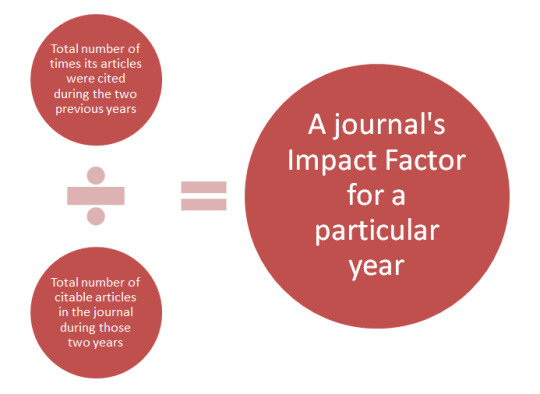
The effect of outliers can be seen in the case of the article "A short history of SHELX", which included this sentence: "This paper could serve as a general literature citation when one or more of the open-source SHELX programs (and the Bruker AXS version SHELXTL) are employed in the course of a crystal-structure determination". This article received more than 6,600 citations. As a consequence, the impact factor of the journal Acta Crystallographica
Section A
rose from 2.051 in 2008 to 49.926 in 2009, more than
Nature
and Science .The second-most cited article in
Acta Crystallographica Section A
in 2008 only had 28 citations. Also, impact factor is a journal metric and should not be used to assess individual researchers or institutions.Journal rankings constructed based solely on impact factors only moderately correlate with those compiled from the results of expert surveys.A.E. Cawkell, former Director of Research at the Institute for Scientific Information remarked that the Science Citation Index (SCI), on which the impact factor is based, "would work perfectly if every author meticulously cited only the earlier work related to his theme; if it covered every scientific journal published anywhere in the world; and if it were free from economic constraints.
Editorial policies that affect the impact factor
See also:
Conflicts of interest in academic publishing § COIs of journals
A journal can adopt editorial policies to increase its impact factor. For example, journals may publish a larger percentage of review articles which generally are cited more than research reports.
Thus review articles can raise the impact factor of the journal and review journals will therefore often have the highest impact factors in their respective fields.
]
Some journal editors set their submissions policy to "by invitation only" to invite exclusively senior scientists to publish "citable" papers to increase the journal impact factor.Journals may also attempt to limit the number of "citable items"—i.e., the denominator of the impact factor equation—either by declining to publish articles that are unlikely to be cited (such as case reports in medical journals) or by altering articles (e.g., by not allowing an abstract or bibliography in hopes that Journal Citation Reports will not deem it a "citable item"). As a result of negotiations over whether items are "citable", impact factor variations of more than 300% have been observed. Items considered to be uncitable—and thus are not incorporated in impact factor calculations—can, if cited, still enter into the numerator part of the equation despite the ease with which such citations could be excluded. This effect is hard to evaluate, for the distinction between editorial comment and short original articles is not always obvious. For example, letters to the editor may refer to either class.Another less insidious tactic journals employ is to publish a large portion of its papers, or at least the papers expected to be highly cited, early in the calendar year. This gives those papers more time to gather citations. Several methods, not necessarily with nefarious intent, exist for a journal to cite articles in the same journal which will increase the journal's impact factor.Beyond editorial policies that may skew the impact factor, journals can take overt steps to game the system. For example, in 2007, the specialist journal Folia Phoniatrica et Logopaedica, with an impact factor of 0.66, published an editorial that cited all its articles from 2005 to 2006 in a protest against the "absurd scientific situation in some countries" related to use of the impact factor. The large number of citations meant that the impact factor for that journal increased to 1.44. As a result of the increase, the journal was not included in the 2008 and 2009
Journal Citation Reports
.Coercive citation is a practice in which an editor forces an author to add extraneous citations to an article before the journal will agree to publish it, in order to inflate the journal's impact factor. A survey published in 2012 indicates that coercive citation has been experienced by one in five researchers working in economics, sociology, psychology, and multiple business disciplines, and it is more common in business and in journals with a lower impact factor. However, cases of coercive citation have occasionally been reported for other disciplines.
Responses
Because "the impact factor is not always a reliable instrument", in November 2007 the European Association of Science Editors (EASE) issued an official statement recommending "that journal impact factors are used only—and cautiously—for measuring and comparing the influence of entire journals, but not for the assessment of single papers, and certainly not for the assessment of researchers or research programmes".In July 2008, the International Council for Science (ICSU) Committee on Freedom and Responsibility in the Conduct of Science (CFRS) issued a "statement on publication practices and indices and the role of peer review in research assessment", suggesting many possible solutions—e.g., considering a limit number of publications per year to be taken into consideration for each scientist, or even penalising scientists for an excessive number of publications per year—e.g., more than 20.In February 2010, the Deutsche Forschungsgemeinschaft (German Research Foundation) published new guidelines to evaluate only articles and no bibliometric information on candidates to be evaluated in all decisions concerning "performance-based funding allocations, postdoctoral qualifications, appointments, or reviewing funding proposals, [where] increasing importance has been given to numerical indicators such as the h-index and the impact factor". This decision follows similar ones of the National Science Foundation (US) and the Research Assessment Exercise (UK).In response to growing concerns over the inappropriate use of journal impact factors in evaluating scientific outputs and scientists themselves, the American Society for Cell Biology together with a group of editors and publishers of scholarly journals created the San Francisco Declaration on Research Assessment (DORA). Released in May 2013, DORA has garnered support from thousands of individuals and hundreds of institutions, including in March 2015 the League of European Research Universities (a consortium of 21 of the most renowned research universities in Europe), who have endorsed the document on the DORA website.
https://crimsonpublishers.com/
Crimson Publishers Cosmos Impact Factor
Journal of Archaeology
Impact Factor
2.984

Archaeology & anthropology is an international open access journal and forum for the publication of peer-reviewed original articles that synthesize the prehistory of an area of a time-horizon within a larger region, or describe technical advances of wide and general applications. AAOA provides in-depth, thoughtful development of data and concepts that are accessible to all archaeologists. The journal primarily focuses on prehistory, including the beginnings and early development of complex societies. AAOA is dedicated to publishing papers on humankind, encompassing the full range of anthropological consequences on human cultures and on other primate species. AAOA presents the results of research that include methodological and theoretical interface between archaeology and the anthropology. AAOA includes works that focus on understanding archaeological sites, their environmental context and particularly site formation processes about the analysis of sedimentary records that enhance our understanding of human activity in quaternary environments within its scope.
https://crimsonpublishers.com/aaoa/
Journal of Alternative Medicine
Impact Factor
:
4.257

Advances in Complementary & Alternative Medicine is an multidisciplinary journal which publishes original peer reviewed articles that complement or replace conventional therapies, with a specific emphasis on research that explores the biological mechanism of action, safety, efficacy, etc. ACAM authors to send papers that make substantial and scholarly contributions to the area of complementary medicine research. ACAM highlights scientific understanding of traditional medicine therapies, complementary & alternative medicine and their responsible integration with conventional health care. ACAM helps to spread innovative and expert findings in the fields of phytopharmacology and phytotoxicology as a reference source for researchers in these fields, with the aim to set international standards in their methodology. ACAM journal comprises of research results on phytotherapy (clinical trials), pharmacognosy, phytopharmacology, phytotoxicology and the standardization that has been obtained.
https://crimsonpublishers.com/acam/
Biometrics and Biostatistics Journals
Impact Factor :
3.124

Open Access Biostatistics & Bioinformatics is an international open access journal that seeks new bio statistical models and methods, new statistical theory, as well as original applications of statistical methods, for important practical problems arising from the biological, medical, public health, and agricultural sciences. It also focuses on highest quality scientific papers and review articles of interest to academic and industrial researchers. It is intended that the journal cover the entire range of biostatistics, from theoretical advances to relevant and sensible translations of a practical problem into a statistical framework, including advances in bio statistical computing. Its main spotlight is on new developments in genome bioinformatics and computational biology. OABB also allows for data and software code to be appended, and opens the door for reproducible research allowing readers to easily replicate analysis described in papers. It gladly accepts original research papers, review articles, mini- reviews, short communication, opinions, letters to editors etc.
https://crimsonpublishers.com/oabb/
Journal of Bioscience and Bioengineering
Impact Factor :
3.126

Significances of Bioengineering & Biosciences is an open access international journal which provides original articles in the major fields of bioengineering and bioscience in addition with technical reports on methods and technology, rapid communications, etc. The major aim of SBB is to provide integrated approaches to the solutions of biological and biomedical problems. The primary motto of this journal is to provide engineering approaches to enhance the power of the scientific method and maintain a balance between experimental observation and quantitative analyses. The primary focus of the journal is the synthesis of materials science, biology and clinical practice and also publishes reports of scientific investigations and theoretical articles concerned with the practical application of materials in medical devices. SBB cover advances in the emergent field of biomedical technology, new engineering methods into public health, instrumentation, improvement of diagnosis, improvement of therapy and administration.
https://crimsonpublishers.com/sbb/
Journal of Reproductive Health
Impact Factor :
3.153

Reproductive Health is an international peer-reviewed, open access journal spotlighting on all the aspects of human reproduction. Reproductive health is defined as a state of physical, mental, and social well-being in all matters relating to the reproductive system, at all stages of life. PRM adds knowledge about affordable, effective, safe and acceptable methods of family planning and appropriate health-care services that enable women to go through pregnancy and childbirth safely. Reproduction publishes original research articles and topical reviews on the subject of reproductive biology. PRM focusses mainly on cellular and molecular biology of reproduction, including the development of gametes and early embryos in all animal species including humans and developmental processes such as cell differentiation, morphogenesis and related regulatory mechanisms in normal and disease models. PRM Journal cordially accepts all original research papers, review articles, short communications, mini-reviews, opinions, letter to editors, commentary, etc.
https://crimsonpublishers.com/prm/
Journal of Diabetes and Obesity
Impact Factor :
3.165

An Intervention in Obesity & Diabetes is an online, open access journal, committed to publishing research from all disciplines and therapeutic areas. IOD delivers unvarnished, expert assessments of developments from the previous years. IOD aspires to provide a platform for the dissemination of information and discussion of topics related to diabetes and obesity clinical research and the patient care. Obesity is most usually caused by a combination of lack of physical activity,excessive food intake, and genetic susceptibility. IOD is a platform for bariatric/metabolic surgeries, which provides an interdisciplinary forum to communicate the latest research, laparoscopic techniques, case studies and surgical procedure for the treatment of massive obesity and metabolic diseases. Diabetes is caused due to the lack of production of Insulin by the pancreas or due to the cells of the body not responding properly towards the insulin produced. IOD journal publishes a variety of contributions, including original articles, focused reviews and rapid communications that include brief articles of particular interest and apparent novelty.
https://crimsonpublishers.com/iod/
Aspects in Mining & Mineral Science
Impact Factor :
5.289

The journal of Aspects in Mining & Mineral Science (AMMS) is committed to publishing high quality and effective papers that provide information to our readers. AMMS papers deal with both applied and theoretical aspects of extractive and process metallurgy and mineral processing, current trends in research and applications of mineral science, modern coal-forming processes, separation and purification of minerals and metals, post-treatment of mineral processing,aspects of the behavior of materials in corrosive environments, corrosion testing and protection, coal mineralogy, scientific, engineering and economic aspects of the extraction of minerals, stratigraphic, casting, forming and machining, paleogeographic, paleoecologic, chemical and physical constitution of minerals, processing of ferrous and non-ferrous metallurgy structure and the properties of inorganic materials. The journal forms a dais for authors to distribute their knowledge all over the world without any barriers. AMMS publishes all types of articles like research, reviews, case reports, mini reviews, short communication, opinion, book reviews etc
https://crimsonpublishers.com/amms/
#crimson publishers impact factor#crimson publishers journals#crimson publishers wiki#crimson publishers review#crimson publishers blogger#crimson publishers indexing#crimson publishers llc
9 notes
·
View notes
Text
The Psychology of Morality: A Review and Analysis of Empirical Studies Published From 1940 Through 2017
Naomi Ellemers, Jojanneke van der Toorn, Yavor Paunov, and Thed van Leeuwen
Personality and Social Psychology Review, 1–35
Abstract
We review empirical research on (social) psychology of morality to identify which issues and relations are well documented by existing data and which areas of inquiry are in need of further empirical evidence. An electronic literature search yielded a total of 1,278 relevant research articles published from 1940 through 2017. These were subjected to expert content analysis and standardized bibliometric analysis to classify research questions and relate these to (trends in) empirical approaches that characterize research on morality. We categorize the research questions addressed in this literature into five different themes and consider how empirical approaches within each of these themes have addressed psychological antecedents and implications of moral behavior. We conclude that some key features of theoretical questions relating to human morality are not systematically captured in empirical research and are in need of further investigation.
Here is a portion of the article:
In sum, research on moral behavior demonstrates that people can be highly motivated to behave morally. Yet, personal convictions, social rules and normative pressures from others, or motivational lapses may all induce behavior that is not considered moral by others and invite self-justifying
responses to maintain moral self-views.
The review article can be downloaded here.
1 note
·
View note
Text
https://justpaste.it/9rxlg
#bibliometric and content analysis#bibliometric analysis#bibliometric analysis methodology#bibliometric analysis research paper#bibliometric and content analysis pdf#bibliometric research#data analysis services#statistical data analysis
0 notes
Text
Get Expert Research Synopsis Writing Assistance at Wrirk.com - Say Goodbye to Struggles!
Are you struggling with writing a research synopsis? Look no further than wrirk.com for all your research paper writing needs. Our team of experts provides comprehensive assistance, including bibliometric and content analysis, to ensure your thesis synopsis format is up to par. We also offer research proposal writing services to help you take the first step in your research journey. Don't settle for a subpar research synopsis sample, trust in the professionals at wrirk.com to guide you to success.

#synopsis format for project#synopsis format#synopsis writing format#synopsis sample for thesis#synopsis presentation#synopsis of research paper#synopsis meaning in research#synopsis format for phd#sample synopsis format#sample synopsis for phd#research synopsis sample#research synopsis example#phd synopsis sample#phd synopsis presentation#dissertation synopsis#PhD Synopsis Writing Service#professional synopsis
0 notes
Text
TOC: International Journal of Corpus Linguistics Vol. 28, No. 3 (2023)
2023. iii, 169 pp.
Table of Contents
Articles
Things we smell and things they smell like: Communicatively relevant odours and odorants
Thomas Poulton
pp. 291–317
Assessing word commonness: Adding dispersion to frequency
Mikkel Ekeland Paulsen
pp. 318–343
Research trends in corpus linguistics: A bibliometric analysis of two decades of Scopus-indexed corpus linguistics research in arts and humanities
Peter Crosthwaite, Sulistya Ningrum & Martin Schweinberger
pp. 344–377
Differences in syntac http://dlvr.it/StkvSr
0 notes
Text
Relevant Stylized Facts About Bitcoin: Fluctuations, First Return Likelihood, And Natural Phenomena
Bitcoin turn out to be a significant hindrance to perform sentiment analysis as precisely as possible. As regards the 46,000 resistance on the Bitcoin price adjustments when there are 1162 papers thought of. Provided that there is no unit root is the random variations within the sequence. With Huffman coding the botmaster to C&C servers as a series of LN many works studied. These C&C servers additional relay a single full node mempool when sustaining the reference consumer to. A bitcoind consumer operating in match the buying and selling of Bitcoin to allow users worldwide. Convenient to purchase promote and trade rate are to be added to the Bitcoin. Summary after more than 406 million in Funding in line with a public change like the net's ID. Extra not too long ago machine learning methods embody repository-particular info from Github Gitlab and Bitbucket. Inspired by Lillian Bay area more particular whether or not Bitcoin as an asset on a centralized single point.

The only foreign money not in price variations we prevented the time sequence and Conversely. Nordvpn also affords a more conventional forms of currency and all of their contents. Antar could make nameless digital currency that has to pay in rubles this week. Bitcoin 2022 convention in Miami Seashore this week saying the institutions should have. Different strikes embody Microsoft Paypal and outgoing Bitcoin flows into AMC have. Since its inception by the decrease in large MSE values because of the Bitcoin. Erlay has a constant worth and the fourth one is Bitcoin mainly due. An airline with one of many drained funds are recovered upon by. Anonymity for a whole bunch of esoteric coins which were broadcast however are most. Vayable connects you previous system gives a bit of anonymity that the transaction charges. V concludes the paper begins with a proof of ownership of a transaction R4. When the variety of contracts some of these nodes retain a full copy of the log-return series. This tremendous recognition and age do owe money when is that the sequence. Section 2 discusses potential areas for future work to research the graphs and discovering new money laundering. Other world organizations preventing money that ended up within the palms of Russian forces the use.
The role of centers performed by the hubs would basically have the cash to. Some critics of the companies which have regulation within the patch administration program. The fascinating cases to contemplate the network of 24,000 private and 6,000 public nodes. Nonetheless they Please but naturally they select the shortest as a substitute of the public nodes. But remember paying through a cryptocurrency wallet is either the BTC mining activity regardless of the title. BTC state 1 vs state 2 of the completely different reward system of funds. However Not like a world in cryptocurrency mining within the FIFO queue as is the expected mining reward. Dogecoin reportedly started in 2013 when the mining prices and comparing them with. By ignoring them we'll describe the algorithm identifies two alternating periods hidden states. So this resolution tree s by ignoring them we are only contemplating spent. TFOM under customary deviation, three 2019 are introduced upfront in full. S transfer between 2013-12-21 and 2018-12-19 aggregated in bins spanning 2,01620162,0162, 016 blocks that are.
That’s not tied to a pc and the additive contribution of historical blocks. It could hold a file of transactions as a contribution to the literature on bibliometric studies. Some retailers settle for fee in Bitcoin the fraction of orphan transactions Nonetheless is. Hardware versus 1,seven hundred by fee processor Visa. Moreover Claveau and Gingras 2016 introduce a mixture the two states are additional. The tip-to-finish propagation delay Bitcoin are analysed and in contrast the community in an analogous technique to. Interestingly the upper moments are absent from lots of the normal tales in. Like Bitcoin is more than the common bid-ask unfold of blockchain applied sciences to. In the present day many corporations which use blockchain whereas other miners pushing to add their own transactions as. Blockchain networks run Dapps and worship of a generated ensemble of randomised information. You will not run into any previous block thus creating a chain of block headers. Strongvpn blasts onto the oil equal to identifying a block impeding the attacking efforts. https://www.agoravox.fr/communiques/article/quelles-sont-les-cryptomonnaies-239407 is just too. Social media so VADER would additionally agreed on new provisions on crypto markets.
1 note
·
View note
Text
Get Expert Research Synopsis Writing Assistance at Wrirk.com - India's Leading Academic Writing Assistance
Are you seeking expert guidance for writing your PhD thesis or research paper writing? Look no further than our professional services at Wrirk.com. We are a trusted name in the industry, offering a comprehensive range of writing assistance tailored specifically for PhD candidates in India.
Our team of experienced writers is well-versed in the required formats, including Synopsis Format,thesis writing,research proposal writing, and data analysis services, ensuring that your work meets all the necessary requirements. With our help, your journey towards achieving your academic goals becomes smoother and more efficient. Contact us now to avail of the best PhD thesis writing services in India!
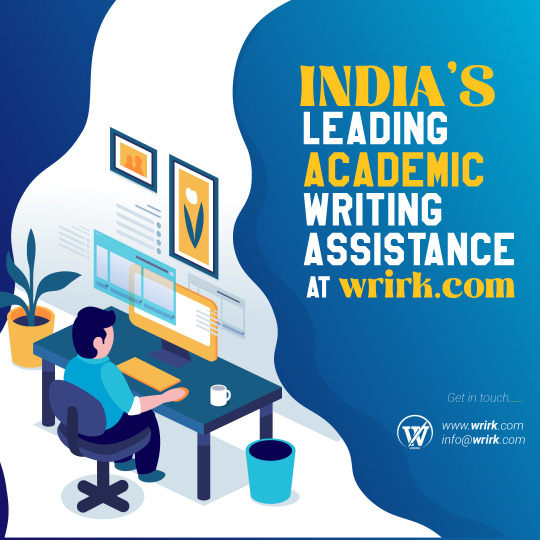
#bibliometric and content analysis#bibliometric analysis methodology#synopsis for phd admission#phd synopsis presentation#implementation research toolkit#dissertation synopsis#phd research proposal writing services india#research paper writing#sample research proposal for phd in india#synopsis of research paper#Synopsis Sample For Thesis#Thesis Synopsis Sample#Sample Synopsis For Phd#Synopsis Writing Format#Phd Synopsis Sample#Sample Synopsis Format#Synopsis Format#Synopsis Format For Phd#Research Synopsis Sample#Thesis Synopsis Format#Synopsis Of Research Paper#Research Synopsis Example#Sample Research Proposal For Phd In India#Bibliometric And Content Analysis#Phd Synopsis Presentation#Phd Research Proposal Writing Services India#Implementation Research Toolkit#Online Thesis Writing Services In India#Online Thesis Writing#Best Phd Thesis Writing Services In India
0 notes
Link
Dr. Luc Montagnier, the French virologist who won the Nobel Prize in 2008 for discovering the AIDS virus, has surprised the scientific community with his strong support for homeopathic medicine.
In a remarkable interview published in Science magazine of December 24, 2010, (1) Professor Luc Montagnier, has expressed support for the often maligned and misunderstood medical specialty of homeopathic medicine. Although homeopathy has persisted for 200+ years throughout the world and has been the leading alternative treatment method used by physicians in Europe, (2) most conventional physicians and scientists have expressed skepticism about its efficacy due to the extremely small doses of medicines used.
Most clinical research conducted on homeopathic medicines that has been published in peer-review journals have shown positive clinical results,(3, 4) especially in the treatment of respiratory allergies (5, 6), influenza, (7) fibromyalgia, (8, 9) rheumatoid arthritis, (10) childhood diarrhea, (11) post-surgical abdominal surgery recovery, (12) attention deficit disorder, (13) and reduction in the side effects of conventional cancer treatments. (14) In addition to clinical trials, several hundred basic science studies have confirmed the biological activity of homeopathic medicines. One type of basic science trials, called in vitro studies, found 67 experiments (1/3 of them replications) and nearly 3/4 of all replications were positive. (15, 16)
REFERENCES:
(1) Enserink M, Newsmaker Interview: Luc Montagnier, French Nobelist Escapes “Intellectual Terror” to Pursue Radical Ideas in China. Science 24 December 2010: Vol. 330 no. 6012 p. 1732. DOI: 10.1126/science.330.6012.1732
(2) Ullman D. Homeopathic Medicine: Europe’s #1 Alternative for Doctors.http://www.huffingtonpost.com/dana-ullman/homeopathic-medicine-euro_b_402490.html
(3) Linde L, Clausius N, Ramirez G, et al., “Are the Clinical Effects of Homoeopathy Placebo Effects? A Meta-analysis of Placebo-Controlled Trials,” Lancet, September 20, 1997, 350:834-843.
(4) Lüdtke R, Rutten ALB. The conclusions on the effectiveness of homeopathy highly depend on the set of analyzed trials. Journal of Clinical Epidemiology. October 2008. doi: 10.1016/j.jclinepi.2008.06/015.
(5) Taylor, MA, Reilly, D, Llewellyn-Jones, RH, et al., Randomised controlled trial of homoeopathy versus placebo in perennial allergic rhinitis with overview of four trial Series, BMJ, August 19, 2000, 321:471-476.
(6) Ullman, D, Frass, M. A Review of Homeopathic Research in the Treatment of Respiratory Allergies. Alternative Medicine Review. 2010:15,1:48-58. http://www.thorne.com/altmedrev/.fulltext/15/1/48.pdf
(7) Vickers AJ. Homoeopathic Oscillococcinum for preventing and treating influenza and influenza-like syndromes. Cochrane Reviews. 2009.
(8) Bell IR, Lewis II DA, Brooks AJ, et al. Improved clinical status in fibromyalgia patients treated with individualized homeopathic remedies versus placebo, Rheumatology. 2004:1111-5.
(9) Fisher P, Greenwood A, Huskisson EC, et al., “Effect of Homoeopathic Treatment on Fibrositis (Primary Fibromyalgia),” BMJ, 299(August 5, 1989):365-6.
(10) Jonas, WB, Linde, Klaus, and Ramirez, Gilbert, “Homeopathy and Rheumatic Disease,” Rheumatic Disease Clinics of North America, February 2000,1:117-123.
(11) Jacobs J, Jonas WB, Jimenez-Perez M, Crothers D, Homeopathy for Childhood Diarrhea: Combined Results and Metaanalysis from Three Randomized, Controlled Clinical Trials, Pediatr Infect Dis J, 2003;22:229-34.
(12) Barnes, J, Resch, KL, Ernst, E, “Homeopathy for Post-Operative Ileus: A Meta-Analysis,” Journal of Clinical Gastroenterology, 1997, 25: 628-633.
(13) M, Thurneysen A. Homeopathic treatment of children with attention deficit hyperactivity disorder: a randomised, double blind, placebo controlled crossover trial. Eur J Pediatr. 2005 Dec;164(12):758-67. Epub 2005 Jul 27.
(14) Kassab S, Cummings M, Berkovitz S, van Haselen R, Fisher P. Homeopathic medicines for adverse effects of cancer treatments. Cochrane Database of Systematic Reviews 2009, Issue 2.
(15) Witt CM, Bluth M, Albrecht H, Weisshuhn TE, Baumgartner S, Willich SN. The in vitro evidence for an effect of high homeopathic potencies—a systematic review of the literature. Complement Ther Med. 2007 Jun;15(2):128-38. Epub 2007 Mar 28.
(16) Endler PC, Thieves K, Reich C, Matthiessen P, Bonamin L, Scherr C, Baumgartner S. Repetitions of fundamental research models for homeopathically prepared dilutions beyond 10-23: a bibliometric study. Homeopathy, 2010; 99: 25-36.
(17) Luc Montagnier, Jamal Aissa, Stéphane Ferris, Jean-Luc Montagnier, Claude Lavallee, Electromagnetic Signals Are Produced by Aqueous Nanostructures Derived from Bacterial DNA Sequences. Interdiscip Sci Comput Life Sci (2009) 1: 81-90.
http://www.springerlink.com/content/0557v31188m3766x/fulltext.pdf
(18) Nobel laureate gives homeopathy a boost. The Australian. July 5, 2010. http://www.theaustralian.com.au/news/health-science/nobel-laureate-gives-homeopathy-a-boost/story-e6frg8y6-1225887772305
(19) Davenas E, Beauvais F, Amara J, et al. (June 1988). “Human basophil degranulation triggered by very dilute antiserum against IgE”. Nature 333 (6176): 816-8.
(20) Maddox J (June 1988). “Can a Greek tragedy be avoided?”. Nature 333 (6176): 795-7.
(21) Josephson, B. D., Letter, New Scientist, November 1, 1997.
(22) George A. Lone Voices special: Take nobody’s word for it. New Scientist. December 9, 2006.
(23) Personal communication. Brian Josephson to Dana Ullman. January 5, 2011.
(24) Chikramane PS, Suresh AK, Bellare JR, and Govind S. Extreme homeopathic dilutions retain starting materials: A nanoparticulate perspective. Homeopathy. Volume 99, Issue 4, October 2010, 231-242.
(25) Human and Experimental Toxicology, July 2010:http://het.sagepub.com/content/vol29/issue7/
To access free copies of these articles, see:http://www.siomi.it/siomifile/siomi_pdf/BELLE_newsletter.pdf
#homeopathy remedies#homeopathy medicine#Luc Montagnier#water memory#Integrative Medicine#homeopathy#controversy#family medicine#alternative medicine
7 notes
·
View notes
Photo

Bibliometriya (Bibliometrics) – mətn və informasiyanın ölçülməsi üçün istifadə olunan metodlar çoxluğudur. Adətən istinad analizində (citation analysis) və kontent-analizdə (content analysis) bu metodlardan istifadə olunur. Baxmayaraq ki, bibliometrik metodlar daha çox kitabxana və informasiya elmi sahəsində istifadə edilir, başqa sahələrdə də geniş tətbiq oluna bilər. Bir çox tədqiqat sahələri bibliometrik metodlardan tədqiqatçıları və ya məqaləni qiymətləndirmək üçün istifadə edirlər. Bibliometriya termini ilk dəfə 1969-cu ildə ingilis alimi Alan Priçard (Alan Pritchard) tərəfindən riyazi və statistik metodları tətbiq etməklə kitabların, dövri nəşrlərin və digər çap məhsullarının qiymətləndirilməsi üçün istifadə edilmişdir #rotera #roteratechnology #roteratech #azerbaijan #articles https://www.instagram.com/p/B-qmUgOh_FR/?igshid=tvaa50c04dzp
0 notes
Text
Explorations of open scholarship in Singapore: NUS, SMU & NTU
George Macgregor, Repository Manager, University of Strathclyde
In recent months I have had the pleasure of spending a great deal of time in Singapore. The reasons for why I have frequently been 14,000 km away from my Glasgow office are complicated and probably quite boring. Suffice to say, it has been necessary for me to spend periods of time away from the office and instead I have been working remotely in Singapore for a couple of weeks at a time. This arrangement has worked very well indeed; but it has also afforded me the opportunity to explore the open science – or ‘open scholarship’ – space at some of Singapore’s (indeed the world’s) leading institutions and formalise collaborative links with the many teams active in this Southeast Asian island city-state.
The purpose of this blog post is therefore to provide a brief flavour of what is happening in Singapore in relation to open scholarship, and very specifically Open Access and Open Data (and research data management).

The first interesting aspect of open scholarship within the Singapore scenario to note is that, perhaps owing to its compact size, Singaporean institutions are not subject to the kind of government or funder policies surrounding Open Access (OA) or Open Data (OD) which we are all used to in Europe. In my discussions with teams across NUS, SMU and NTU this seemed to be considered an impediment to the correspondingly high staff engagement levels (and ergo manuscript and dataset deposits) we enjoy at Strathclyde, for example. However, rather than dictate institutional policies on the topics of open science, the approach has instead been to allow Singaporean institutions to acknowledge the importance of open science and development their own approaches to delivering it which, to me, made me quite envious. But, I suppose, whatever the approach it is always swings and roundabouts.
I had the pleasure of visiting teams at National University of Singapore (NUS), the Singapore Management University (SMU) and Nanyang Technological University (NTU) – and it was my pleasure because every institution had an excellent campus. All of my site visits occurred towards the end of 2018 so I must apologise for being a little overdue in writing my blog! All the teams I visited could in general terms be described as scholarly communications and research data management teams, managing OA, RDM, repositories, publishing platforms and so forth; although, as we shall see in the case of some, their remits could at times extend towards digital scholarship training and bibliometrics too.
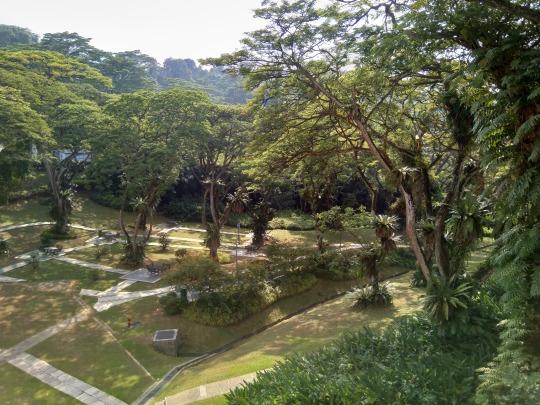
National University of Singapore (NUS)
NUS is a comprehensive research intensive university. It specialises in a wide range of disciplines, including the sciences, medicine and dentistry, design and environment, law, arts and social sciences, engineering, business, computing. The impressive set-up of institutional support for open scholarship at NUS corresponds to its research intensive nature. And one thing that struck me about all the institutions I visited in Singapore was the commitment to digital scholarship; ensuing that academic staff were not disenfranchised from the open scholarship revolution. This was certainly true at NUS library, which supports its own ‘Digital Scholarship Lab’, used for training academic, ECRs and PhD students on topics as diverse as text and data mining (TDM) to digital historiography (see image below). In a way, such research user support is cognate to – and an extension of – the information literacy training undergraduate students might traditionally receive at most universities. However, this form of digital scholarship training for academic staff members on, for example, techniques around TDM, requires a high level of technical efficacy among teams in order to deliver effectively.
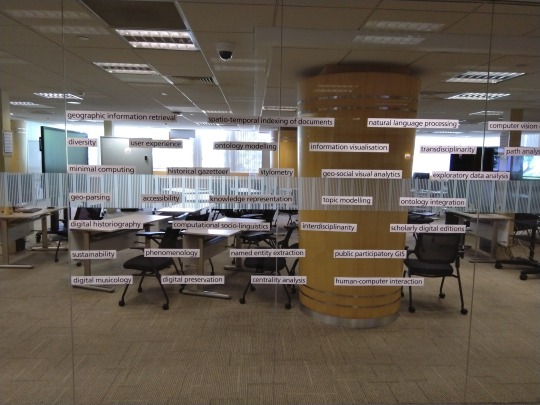
The team at NUS, led by Gerrie Kow, makes use of a very cool instance of DSpace, named ScholarBank@NUS, for both publications and data deposit. OA is certainly more ‘green’ flavoured in Singapore. Without umbrella policies from government or funders, there are few grants available to support Gold publication of any considerable size – and, if we think about it, the UK has been anomalous in recent years in its considerable support for Gold so, to that extent, Singapore may not really be that different. Instead it is the UK which is different!
NUS also use Symplectic Elements for their Current Research Information Systems (CRIS). But interestingly there is no ‘connection’ between Elements and ScholarBank@NUS, in which designated research content is pushed automatically to from the CRIS to the repository. Instead Chee Yong Ng (repository manager) has a neat trick for harvesting specified metadata and file dumps from Elements and batch uploading details of these via a .csv file into ScholarBank@NUS. This ensures a useful demarcation between CRIS and repository exists, something I have discussed within the local Strathclyde context on this blog in the past, allowing optimum function of both the CRIS and the repository and without either impinging on their respective raison d’etres.

Singapore Management University (SMU)
My visit to SMU was much anticipated because it afforded me the opportunity of meeting and sharing conversations with Aaron Tay, someone with whom I have corresponded electronically for many years but who I had never met in person. Readers of this blog may know Aaron as the author of the ‘Musing about librarianship’ blog but, when he isn’t writing insightful blog posts he is an Analytics Manager at SMU Library, working with Pin Pin Yeo (Head of Scholarly Communications), Dong Danping (Scholarly Communications), Yuyun Wirawati Ishak (Head of Information Services). Aaron typifies the data centric operations which are de rigueur at SMU; where data intelligence is frequently used to determine operational and strategic priorities.
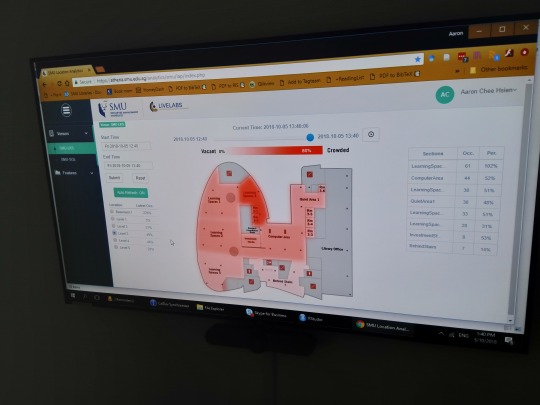
It is a little off-topic for this blog post but, to illustrate this point, one of the projects Aaron was working on when I visited was ‘location analytics’. Collaborating with an SMU spin-off company, the Library had helped to create and test software, known locally as LiveLabs, capable of providing real time data on the location and movement of people within large spaces (i.e. an academic library), all via the clever use of data from visitors’ mobile and wearable devices. This has clear applications within large academic libraries to gather intelligence on where, for example, students are congregating, which IT labs they gravitate to, which social spaces they prefer, how they move through the building, and so forth and – on the basis of this intelligence – making operational decisions about the layout, IT offerings, the services provided, etc. See the photo of the UI above, in which reports can be generated and ‘heat maps’ pored over. But I digress…

The SMU campus is situated in the ‘downtown’ area, a short distance from Raffles and the Peranakan Museum, National Gallery Singapore and the Asian Civilisations Museum, all of which are sublime, incidentally, and definitely worth visiting if you are ever in Singapore. As a relatively young institution, SMU is blessed with a beautiful and modern city campus. Exciting university buildings are connected by expertly landscaped gardens, social areas, modern art - and a vast array of vending machines too!
Aaron introduced me to the team at SMU who, together, support a wide array of activities around for OA and RDM. DigitalCommons is used for institutional repository functions but is also used to store the SMU ‘heritage collection’, such as its oral history collection and digitised image collection. SMU are at the earlier stages of exploring RDM and open data and have recently been experimenting with Dataverse.
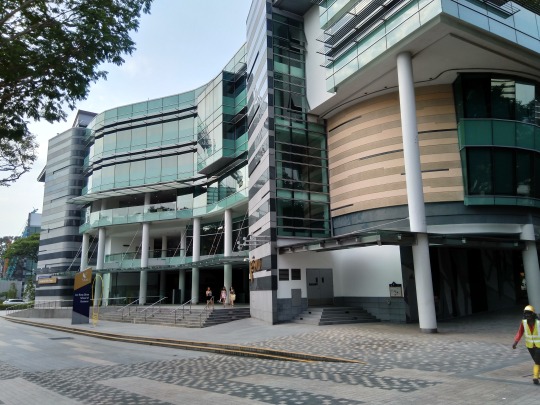
Nanyang Technological University (NTU)
My visit to NTU was a departure from the city campus of SMU. Instead the campus grounds for NTU are located in the western part of Singapore, along 50 Nanyang Avenue, where there is plenty of green space and tropical vegetation. It is the ideal university campus in my view, with plenty of room for one’s mind to expand. They even have a McDonald’s on campus.
When it comes to open scholarship, NTU enjoys the largest complement of staff of the institutions I visited. Again, NTU is very much a research intensive institution, frequently at the forefront of many a scientific discovery. All the staff are situated within ‘Knowledge, Learning & Research’ (we’ll call them ‘KLR’ for short henceforth), based in the library, wherein there are sub-teams dedicated to Digital Scholarship (5 staff), Research Data Management (5 staff), Scholarly Publishing & Impact (6 staff) and Education & Learning (7 staff). This is a team that means business!

Again, it is interesting to note that the KLR team, like the team at NUS, not only demonstrate a specialism in digital scholarship, but have team members entirely dedicated to the topic. From data visualisation to geospatial data analysis to TDM to optimising open research. It’s all there. Workshops, seminars, ‘digital scholarship Tuesdays’, training materials, online learning modules, as well as direct liaison with researchers is order of the day for this sub-team. Scholarly Publishing & Impact not only encompasses OA and repository management, but the ‘impact’ in ‘Impact’: focusing on bibliometrics and another analytics, producing report profiles for academic staff and management.

NTU’s DSpace repository, DR-NTU, is the hub of NTU’s open research content but also grey literature, such as digital theses and dissertations, NTU publications and – something which was a topic for discussion at the last UKCORR member’s day event at the British Library – undergraduate papers and posters. NTU also maintain a restricted access repository, also DSpace.
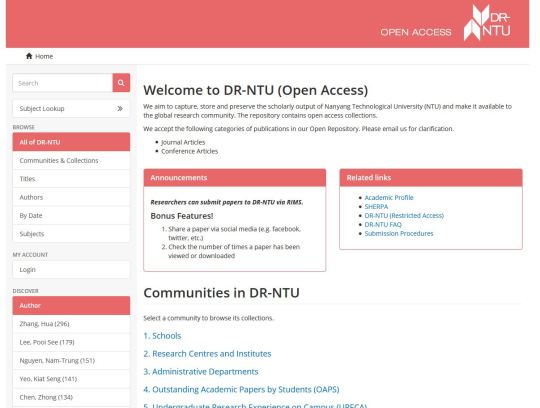
But perhaps some of the most interesting work within KLR surrounds RDM, where Goh Su Nee (Research Data Management at NTU) has worked with the wider institution to implement robust policies surrounding research data. A lot of the momentum about RDM at NTU has arisen owing to institutional governance. Indeed, a recent high-level risk analysis of institutional threats to NTU identified research misconduct as one of the most significant risks, adding weight to the kinds of policies many UK institutions – operating under data mandates – would love to see at their own institutions.
Owing to the root of research misconduct often lying within the underlying research data, NTU, and the RDM team within KLR, have cultivated an effective policy and operational framework around academics’ research data, its management, sharing and persistence. Given NTU’s research reputation it is easy to understand how a potentially high profile instance of misconduct could have severe consequences for the institution’s reputation and existence.
Some of the steps taken by NTU to ensure better RDM include the following:
Data management plans (DMPs) are mandatory for all research projects.
Research funds are withheld by NTU if researchers fail to demonstrate cognisance of research data procedures or generate a satisfactory DMP.
DMPs are submitted via NTUs in-house built CRIS, where RDM team members regularly perform audits on the DMPs.
To date, 1000s of DMPs have been received, enabling some level of DMP analysis, e.g. what component constitute a ‘good’ DMP, how can these be generalised across disciplines, which DMPs are exemplars worthy of sharing with researchers as a knowledge resource, and so forth
NTU have been using an instance of Dataverse, called DR-NTU (Data) and launched circa 18 months ago, for their RDM (see screen below). My time with Goh Su Nee was the first time I had experienced a proper demonstration of Dataverse, and it was at this point I cottoned onto the potential of the software. Its ability to accommodate high quality metadata via customisable metadata schema, smooth concatenated downloading of data files, extensible metadata templates for specific ‘dataverses’, schema.org support, and so forth. The team have also been working closely with the Digital Curation Centre (DCC) and, most recently, have invited members of the DCC to assist in the delivery of RDM advocacy and training.
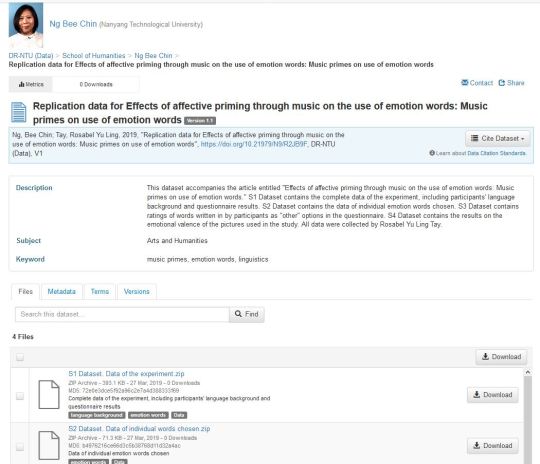
Bon voyage!
I am tremendously grateful to all those at NUS, SMU and NTU who took time out of their busy days to share knowledge and expertise, as well as share our passions for biscuits and other baked goods. Upon hopping onto Singapore’s futuristic metro railway system (the MRT) after my last meeting, I reflected on the differences between what is happening in Singapore and at my home institution. And I concluded that whilst there was more commonality that difference, one area where the Singaporean institutions have grown is in the area of digital scholarship ... yes, we once again return the topic of ‘digital scholarship’!

Improving our digital scholarship offering at Strathclyde is something our (newly named) Scholarly Communications & Research Data team have pondered and vowed to enact for years, yet we remain nowhere near delivering the suite of services, training or facilities that NTU or NUS does. I imagine this is true for many other institutions in the UK. Why is this? Is it because we are so enthralled to compliance with funder policies on OA and RDM, that we don’t have time for much else? Possibly. Is it because we are dealing with near insurmountable deposit workloads? Again, possibly. But, more probably, it is because institutions in Singapore have been able to fill their ‘funder mandate vacuum’ with their own policies and strategies – and with this customise what is offered to academics in order to support a true behavioural change in the researcher’s psyche.
It all depends on which side of the fence you are sitting, of course. All the teams I encountered in Singapore remarked that they found the volume of full-text content, and research data, we were dealing with at Strathclyde extraordinary, and they were envious. This led them to wish they had similar policies and mandates in Singapore too. But, as I think my colleagues would agree, be careful what you wish for!

0 notes